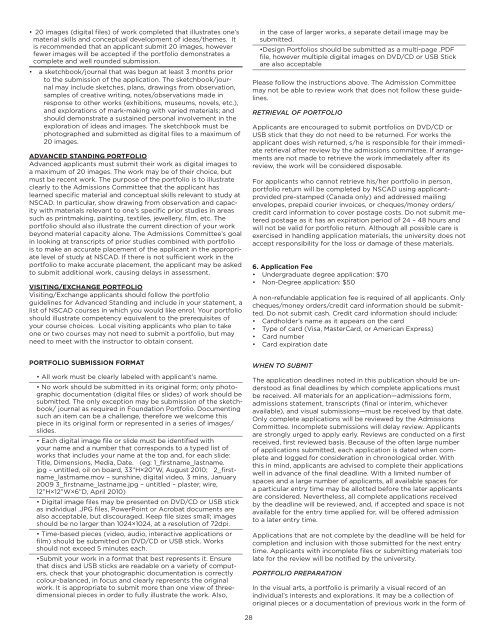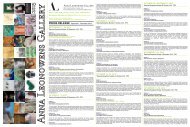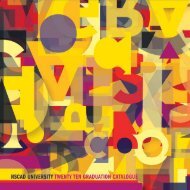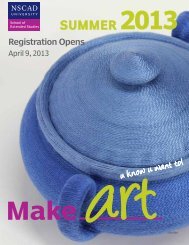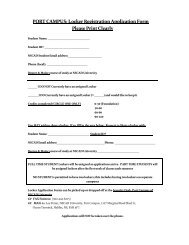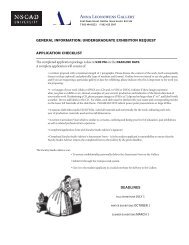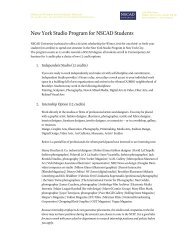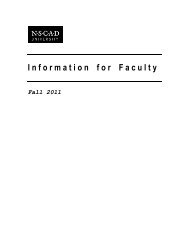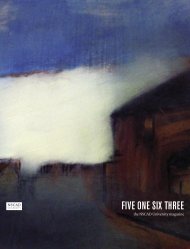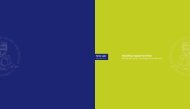CONTENTS - Nova Scotia College of Art and Design
CONTENTS - Nova Scotia College of Art and Design
CONTENTS - Nova Scotia College of Art and Design
You also want an ePaper? Increase the reach of your titles
YUMPU automatically turns print PDFs into web optimized ePapers that Google loves.
• 20 images (digital files) <strong>of</strong> work completed that illustrates one’s<br />
material skills <strong>and</strong> conceptual development <strong>of</strong> ideas/themes. It<br />
is recommended that an applicant submit 20 images, however<br />
fewer images will be accepted if the portfolio demonstrates a<br />
complete <strong>and</strong> well rounded submission.<br />
• a sketchbook/journal that was begun at least 3 months prior<br />
to the submission <strong>of</strong> the application. The sketchbook/journal<br />
may include sketches, plans, drawings from observation,<br />
samples <strong>of</strong> creative writing, notes/observations made in<br />
response to other works (exhibitions, museums, novels, etc.),<br />
<strong>and</strong> explorations <strong>of</strong> mark-making with varied materials; <strong>and</strong><br />
should demonstrate a sustained personal involvement in the<br />
exploration <strong>of</strong> ideas <strong>and</strong> images. The sketchbook must be<br />
photographed <strong>and</strong> submitted as digital files to a maximum <strong>of</strong><br />
20 images.<br />
ADVANCED STANDING PORTFOLIO<br />
Advanced applicants must submit their work as digital images to<br />
a maximum <strong>of</strong> 20 images. The work may be <strong>of</strong> their choice, but<br />
must be recent work. The purpose <strong>of</strong> the portfolio is to illustrate<br />
clearly to the Admissions Committee that the applicant has<br />
learned specific material <strong>and</strong> conceptual skills relevant to study at<br />
NSCAD. In particular, show drawing from observation <strong>and</strong> capacity<br />
with materials relevant to one’s specific prior studies in areas<br />
such as printmaking, painting, textiles, jewellery, film, etc. The<br />
portfolio should also illustrate the current direction <strong>of</strong> your work<br />
beyond material capacity alone. The Admissions Committee’s goal<br />
in looking at transcripts <strong>of</strong> prior studies combined with portfolio<br />
is to make an accurate placement <strong>of</strong> the applicant in the appropriate<br />
level <strong>of</strong> study at NSCAD. If there is not sufficient work in the<br />
portfolio to make accurate placement, the applicant may be asked<br />
to submit additional work, causing delays in assessment.<br />
VISITING/EXCHANGE PORTFOLIO<br />
Visiting/Exchange applicants should follow the portfolio<br />
guidelines for Advanced St<strong>and</strong>ing <strong>and</strong> include in your statement, a<br />
list <strong>of</strong> NSCAD courses in which you would like enrol. Your portfolio<br />
should illustrate competency equivalent to the prerequisites <strong>of</strong><br />
your course choices. Local visiting applicants who plan to take<br />
one or two courses may not need to submit a portfolio, but may<br />
need to meet with the instructor to obtain consent.<br />
PORTFOLIO SUBMISSION FORMAT<br />
• All work must be clearly labeled with applicant’s name.<br />
• No work should be submitted in its original form; only photographic<br />
documentation (digital files or slides) <strong>of</strong> work should be<br />
submitted. The only exception may be submission <strong>of</strong> the sketchbook/<br />
journal as required in Foundation Portfolio. Documenting<br />
such an item can be a challenge, therefore we welcome this<br />
piece in its original form or represented in a series <strong>of</strong> images/<br />
slides.<br />
• Each digital image file or slide must be identified with<br />
your name <strong>and</strong> a number that corresponds to a typed list <strong>of</strong><br />
works that includes your name at the top <strong>and</strong>, for each slide:<br />
Title, Dimensions, Media, Date. (eg: 1_firstname_lastname.<br />
jpg – untitled, oil on board, 33”H×20”W, August 2010; 2_firstname_lastmame.mov<br />
– sunshine, digital video, 3 mins, January<br />
2009 3_firstname_lastname.jpg – untitled – plaster, wire,<br />
12”H×12”W×6”D, April 2010)<br />
• Digital image files may be presented on DVD/CD or USB stick<br />
as individual .JPG files, PowerPoint or Acrobat documents are<br />
also acceptable, but discouraged. Keep file sizes small; images<br />
should be no larger than 1024×1024, at a resolution <strong>of</strong> 72dpi.<br />
• Time-based pieces (video, audio, interactive applications or<br />
film) should be submitted on DVD/CD or USB stick. Works<br />
should not exceed 5 minutes each.<br />
•Submit your work in a format that best represents it. Ensure<br />
that discs <strong>and</strong> USB sticks are readable on a variety <strong>of</strong> computers,<br />
check that your photographic documentation is correctly<br />
colour-balanced, in focus <strong>and</strong> clearly represents the original<br />
work. It is appropriate to submit more than one view <strong>of</strong> threedimensional<br />
pieces in order to fully illustrate the work. Also,<br />
28<br />
in the case <strong>of</strong> larger works, a separate detail image may be<br />
submitted.<br />
•<strong>Design</strong> Portfolios should be submitted as a multi-page .PDF<br />
file, however multiple digital images on DVD/CD or USB Stick<br />
are also acceptable<br />
Please follow the instructions above. The Admission Committee<br />
may not be able to review work that does not follow these guidelines.<br />
RETRIEVAL OF PORTFOLIO<br />
Applicants are encouraged to submit portfolios on DVD/CD or<br />
USB stick that they do not need to be returned. For works the<br />
applicant does wish returned, s/he is responsible for their immediate<br />
retrieval after review by the admissions committee. If arrangements<br />
are not made to retrieve the work immediately after its<br />
review, the work will be considered disposable.<br />
For applicants who cannot retrieve his/her portfolio in person,<br />
portfolio return will be completed by NSCAD using applicantprovided<br />
pre-stamped (Canada only) <strong>and</strong> addressed mailing<br />
envelopes, prepaid courier invoices, or cheques/money orders/<br />
credit card information to cover postage costs. Do not submit metered<br />
postage as it has an expiration period <strong>of</strong> 24 – 48 hours <strong>and</strong><br />
will not be valid for portfolio return. Although all possible care is<br />
exercised in h<strong>and</strong>ling application materials, the university does not<br />
accept responsibility for the loss or damage <strong>of</strong> these materials.<br />
6. Application Fee<br />
• Undergraduate degree application: $70<br />
• Non-Degree application: $50<br />
A non-refundable application fee is required <strong>of</strong> all applicants. Only<br />
cheques/money orders/credit card information should be submitted.<br />
Do not submit cash. Credit card information should include:<br />
• Cardholder’s name as it appears on the card<br />
• Type <strong>of</strong> card (Visa, MasterCard, or American Express)<br />
• Card number<br />
• Card expiration date<br />
WHEN TO SUBMIT<br />
The application deadlines noted in this publication should be understood<br />
as final deadlines by which complete applications must<br />
be received. All materials for an application—admissions form,<br />
admissions statement, transcripts (final or interim, whichever<br />
available), <strong>and</strong> visual submissions—must be received by that date.<br />
Only complete applications will be reviewed by the Admissions<br />
Committee. Incomplete submissions will delay review. Applicants<br />
are strongly urged to apply early. Reviews are conducted on a first<br />
received, first reviewed basis. Because <strong>of</strong> the <strong>of</strong>ten large number<br />
<strong>of</strong> applications submitted, each application is dated when complete<br />
<strong>and</strong> logged for consideration in chronological order. With<br />
this in mind, applicants are advised to complete their applications<br />
well in advance <strong>of</strong> the final deadline. With a limited number <strong>of</strong><br />
spaces <strong>and</strong> a large number <strong>of</strong> applicants, all available spaces for<br />
a particular entry time may be allotted before the later applicants<br />
are considered. Nevertheless, all complete applications received<br />
by the deadline will be reviewed, <strong>and</strong>, if accepted <strong>and</strong> space is not<br />
available for the entry time applied for, will be <strong>of</strong>fered admission<br />
to a later entry time.<br />
Applications that are not complete by the deadline will be held for<br />
completion <strong>and</strong> inclusion with those submitted for the next entry<br />
time. Applicants with incomplete files or submitting materials too<br />
late for the review will be notified by the university.<br />
PORTFOLIO PREPARATION<br />
In the visual arts, a portfolio is primarily a visual record <strong>of</strong> an<br />
individual’s interests <strong>and</strong> explorations. It may be a collection <strong>of</strong><br />
original pieces or a documentation <strong>of</strong> previous work in the form <strong>of</strong>


